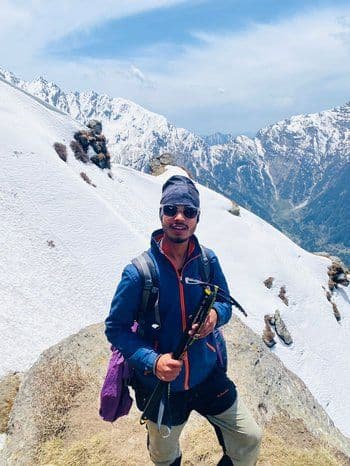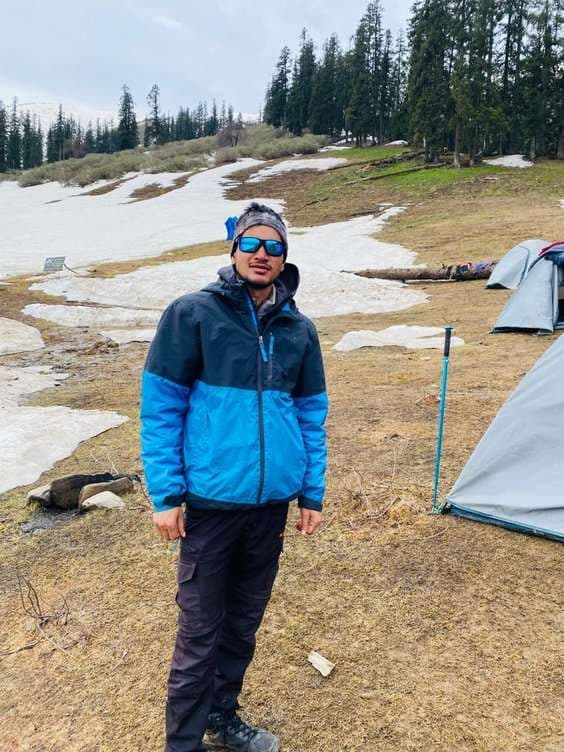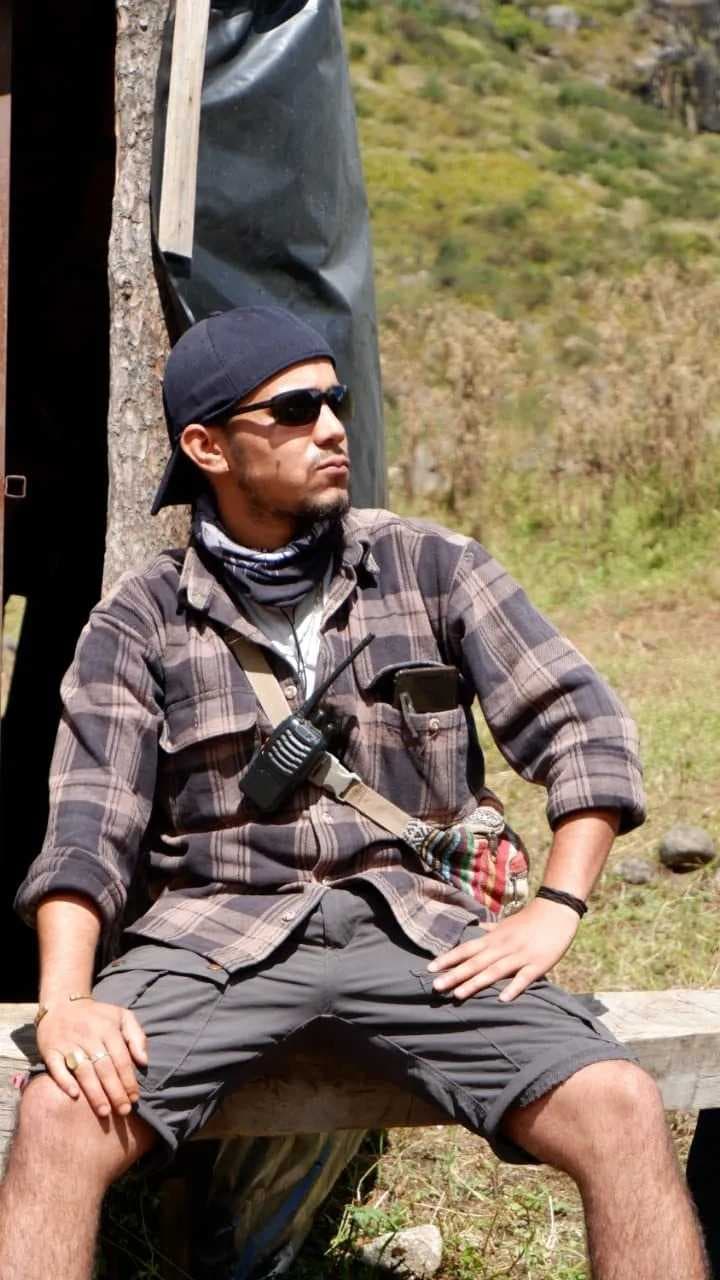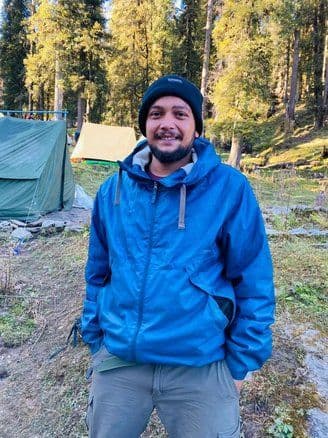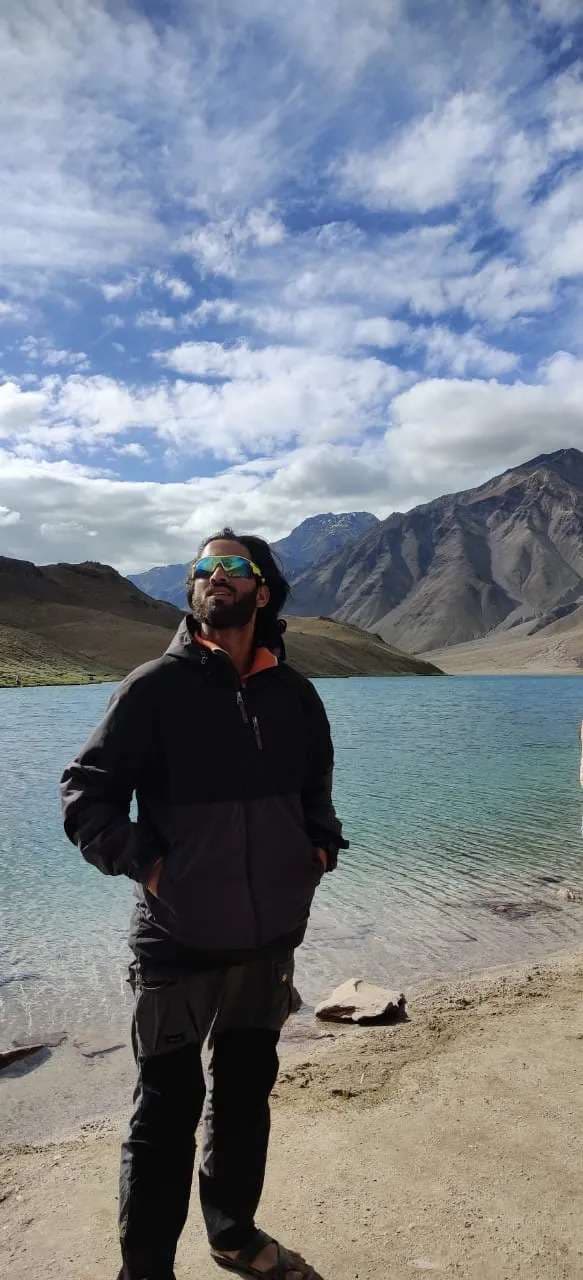Jogin III, also known as Jogin III Peak, is one of the notable peaks in the Garhwal Himalayas of Uttarakhand, India. It is part of the Jogin Group of peaks, which is located in the Gangotri region, a renowned destination for mountaineers and trekkers. Jogin III is situated in the Garhwal Himalayas, specifically within the Gangotri Group of peaks. It is positioned south of the Bhagirathi River and southwest of the Gangotri Glacier, making it a prominent feature of the region's stunning landscape.Jogin III has a history of attracting mountaineers and climbers who seek to conquer its challenging heights. The exact details of its first ascent are not widely documented, but it has been the target of numerous climbing expeditions over the years.Jogin III stands at an impressive elevation, although the precise height may vary depending on the source. It is typically estimated to be around 6,238 meters (approximately 20,462 feet) above sea level.
Climbing Routes:
Climbing routes to Jogin III usually involve a combination of ice and rock climbing techniques.
The mountain offers a variety of challenging routes that attract both experienced climbers and adventurers looking to test their skills.
Significance:
Like many peaks in the Garhwal Himalayas, Jogin III holds cultural and spiritual significance, particularly for the local communities in the region.
The surrounding area is known for its sacred temples and pilgrimage sites, adding to the cultural richness of the landscape.
Challenges:
Climbing Jogin III presents significant challenges due to its high altitude and technical difficulties.
Climbers must be well-prepared, acclimatized, and equipped to handle the rigors of high-altitude mountaineering.
Conservation:
The entire Garhwal region, including Jogin III, falls within the protected areas of the Nanda Devi Biosphere Reserve.
Conservation efforts are in place to safeguard the unique flora and fauna of the region, which includes the habitat around Jogin III.
Jogin III continues to be an alluring destination for mountaineers, offering not only the thrill of climbing but also the opportunity to immerse oneself in the natural beauty and cultural heritage of the Garhwal Himalayas. However, scaling this peak requires careful planning, technical expertise, and respect for the environment to ensure a safe and rewarding mountaineering experience.
Best Time For Expedition Of Jogin III
The best time to visit Jogin III and the surrounding Garhwal Himalayas for trekking and mountaineering typically falls within the summer and post-monsoon months. Here are the best times to consider for visiting Jogin III:
Late May to Early June (Pre-Monsoon):
This period marks the beginning of the trekking and climbing season in the Garhwal Himalayas. The weather is relatively stable with clear skies, making it an ideal time for mountaineering expeditions. Temperatures are moderate at lower altitudes, but it can still be quite cold at higher elevations.
Late September to Early October (Post-Monsoon):
After the monsoon season, the skies clear up again, and the weather becomes favorable for trekking and climbing. The post-monsoon period offers stunning views of the surrounding landscapes with lush greenery. The temperatures are comfortable during the day but can drop significantly at night.
Avoid the Monsoon Season (July to Early September):
Monsoon rains can make trekking and climbing extremely challenging, and the region is prone to landslides and flooding during this time. It's highly recommended to avoid planning any expeditions during the monsoon season.
Late October to Early November (Autumn):
While late autumn can be a good time for trekking, it's important to note that higher-altitude areas may experience early snowfall, which can make conditions more difficult.
March to Early May (Spring):
In early spring, some lower-altitude trekking routes may become accessible, but higher-altitude areas are still covered in snow, making it less suitable for Jogin III expeditions.
Please keep in mind that weather conditions in the Himalayas can be unpredictable, and it's crucial to check local forecasts and conditions before planning your trip. Additionally, it's advisable to consult with experienced guides or expedition organizers who are familiar with the specific challenges and conditions of the Jogin III region before embarking on your adventure.
How To Reach Dehradun
Nestled in the foothills of the majestic Himalayas, Dehradun serves as the perfect gateway for those seeking adventure, serenity, and natural beauty. Whether you're a trekking enthusiast or simply looking to explore the pristine landscapes of Uttarakhand, Dehradun is your starting point. In this guide, we'll explore various ways to reach Dehradun, ensuring your journey is as smooth as possible.
By Air:
Dehradun Airport: Dehradun has its own airport, Jolly Grant Airport (DED), which is well-connected to major cities in India. If you're traveling from afar, catching a flight is the fastest way to reach Dehradun. Domestic airlines like IndiGo, SpiceJet, and Air India operate regular flights to and from Dehradun. Once you land at the airport, you'll be just a short drive away from the city center.
By Train:
Dehradun Railway Station: For those who prefer train journeys, the Dehradun Railway Station (DDN) is the most convenient option. It's connected to several major cities, including Delhi, Mumbai, Kolkata, and Varanasi. The Shatabdi Express and Mussoorie Express are popular choices for travelers coming from Delhi. The railway station is situated in the heart of Dehradun, making it easy to access various parts of the city.
By Road:
Scenic Drives to Dehradun: If you enjoy road trips and want to savor the picturesque landscapes of Uttarakhand, traveling to Dehradun by road is a fantastic option. Here are a few routes you can take:
Route 1: Delhi to Dehradun
Distance: Approximately 250 kilometers
Time: 6-7 hours
Take NH44 from Delhi, pass through Ghaziabad, and follow the signs for Dehradun. The journey is dotted with beautiful views and offers a chance to stop at local dhabas for delicious North Indian cuisine.
Route 2: Haridwar to Dehradun
Distance: Approximately 53 kilometers
Time: 1.5-2 hours
If you're visiting Haridwar first, you can drive to Dehradun easily via NH34. This route takes you through lush forests and along the Ganges River.
Route 3: Rishikesh to Dehradun
Distance: Approximately 45 kilometers
Time: 1-1.5 hours
Rishikesh, another adventure hub, is close to Dehradun. Take NH7 to reach your destination, and enjoy the scenic drive through the hills.
Local Transportation in Dehradun: Once you arrive in Dehradun, getting around the city is hassle-free. You can use local transportation options like auto-rickshaws, cycle rickshaws, and taxis. Additionally, there are well-established bus services that connect different parts of the city.
Planning Your Himalayan Adventure
Dehradun isn't just a transit point; it's a destination in itself. Before embarking on your Himalayan adventure, take some time to explore the city's attractions:
Robber's Cave: A natural cave formation known for its narrow passages and cool streams, perfect for a refreshing dip.
Sahastradhara: Famous for its therapeutic sulfur springs and breathtaking waterfalls, this place is a must-visit for nature lovers.
Tapkeshwar Temple: An ancient Shiva temple located in a cave, it's a sacred site with a tranquil ambiance.
Malsi Deer Park: Ideal for wildlife enthusiasts, this park houses various deer species and offers a serene environment for picnics.
Now that you know how to reach Dehradun and have a glimpse of what the city has to offer, you're all set to embark on your Himalayan trekking adventure. Whether you're heading to the famous Valley of Flowers, the challenging Har Ki Dun trek, or any other exciting trek in the region, Dehradun is your starting point for unforgettable experiences in the Himalayas.So, pack your bags, gather your trekking gear, and get ready to explore the breathtaking beauty of the Himalayas, beginning with the charming city of Dehradun.
Things To Carry For Jogin III Expedition
Preparing for an expedition to Jogin III in the Himalayas requires careful consideration of the gear and essentials you'll need to ensure a safe and enjoyable trek. Here's a detailed list of things to carry for your Jogin III expedition:
Clothing:
Trekking Boots: High-quality waterproof trekking boots with good ankle support.
Moisture-Wicking Base Layers: Lightweight, breathable shirts and pants to manage sweat and moisture.
Insulating Layers: Fleece or down jacket for warmth in colder conditions.
Waterproof Jacket: A durable, waterproof, and windproof jacket to protect against rain and snow.
Trekking Pants: Lightweight, quick-drying pants suitable for trekking.
Trekking Socks: Several pairs of moisture-wicking and warm socks.
Warm Hat: A wool or fleece hat to keep your head warm.
Gloves: Insulated, waterproof gloves for protecting your hands from cold and wet conditions.
Buff or Scarf: To cover your face and neck from cold winds.
Sunglasses: UV-protective sunglasses with side shields to shield your eyes from the sun.
Sun Hat: A wide-brimmed hat to protect your face and neck from the sun.
Backpack and Gear:
Backpack: A comfortable and sturdy backpack with enough space for your essentials. A 50-70 liter capacity is recommended.
Sleeping Bag: A cold-weather sleeping bag suitable for high altitudes.
Trekking Poles: To provide stability and reduce strain on your knees during descents.
Headlamp: A good-quality headlamp with extra batteries for night trekking and camping.
Water Bottles/Hydration System: At least two 1-liter water bottles or a hydration reservoir.
Personal Items:
Identification: Carry identification documents, permits, and emergency contact information in a waterproof pouch.
Mobile Phone: A fully charged mobile phone with emergency contact numbers saved.
Power Bank: To recharge your devices during the trek.
Camera: If you're a photography enthusiast, bring a camera to capture the stunning landscapes.
Cash: Carry some cash for emergencies and small expenses in villages along the way.
Map and Compass/GPS: Navigation tools to ensure you stay on the right path.
Toiletries and Personal Hygiene:
Toilet Paper: Pack some in a waterproof bag.
Toiletry Kit: Toothbrush, toothpaste, soap, and a small towel.
Hand Sanitizer: For maintaining hygiene on the trail.
First Aid Kit:
Basic First Aid Kit: Including bandages, antiseptic wipes, adhesive tape, pain relievers, and any personal medications.
Blister Treatment: Moleskin or blister pads.
Prescription Medications: If you have specific medical needs.
Food and Water:
Snacks: High-energy snacks like nuts, dried fruits, energy bars, and chocolates.
Water Purification: Water purification tablets or a filter to ensure safe drinking water from natural sources.
Reusable Water Bottle: To carry and store treated water.
Camping Gear (if camping):
Tent: Lightweight and weatherproof.
Sleeping Pad: To provide insulation and comfort during camping.
Cooking Equipment: Stove, cookware, utensils, and fuel.
Food: Dehydrated or freeze-dried meals for camping.
Miscellaneous:
Backpack Rain Cover: To keep your gear dry during rain showers.
Trash Bags: For packing out all trash and adhering to Leave No Trace principles.
Repair Kit: Duct tape, multi-tool, and repair materials for gear.
Book or Entertainment: Something to pass the time during rest periods.
Whistle: A whistle can be a useful emergency signaling device.
Optional Items:
Trekking Gaiters: To keep debris out of your boots.
Camera Tripod: For stable photography in scenic locations.
Binoculars: For wildlife and landscape viewing.
Personal Locator Beacon (PLB): For remote areas with no cellular signal.
Remember that the specific gear and items you need may vary based on your personal preferences, the time of year you're trekking, and the local conditions. Ensure that all your gear is in good condition and well-maintained before embarking on your Jogin III expedition. Additionally, consider hiring a local guide who can provide valuable insights and assist with planning and safety throughout your trek.
How To Prepare For Expedition To Jogin III
Jogin III, a hidden gem in the heart of the Himalayas, beckons trekkers with its pristine beauty, lush meadows, and towering peaks. Located in Uttarakhand, this trek offers an experience that is both physically demanding and spiritually rewarding. To make the most of your journey to Jogin III, thorough preparation is key. In this guide, we'll take you through the essential steps to get ready for this unforgettable Himalayan adventure.
Understanding the Trek
Before you start preparing for Jogin III, it's crucial to have a good understanding of the trek itself. Here are some key details:
Location: Jogin III is situated in the Gangotri region of Uttarakhand, India.
Duration: The trek typically takes around 8-10 days, including travel to and from the base camp.
Difficulty: This trek is considered moderately difficult, with challenging terrains and altitude gain.
Physical Fitness:
Jogin III demands a good level of physical fitness due to the challenging terrain and altitude. Here's how to prepare your body:
Cardiovascular Training: Engage in regular cardio exercises like running, swimming, or cycling to build endurance. Strength Training: Strengthen your leg muscles, core, and upper body through strength training exercises. Squats, lunges, and planks are beneficial.
Altitude Training: If possible, spend time at high altitudes before the trek to acclimatize your body.
Hiking Practice: Go for long hikes, preferably in hilly or mountainous terrain, to get accustomed to walking on uneven surfaces.
Flexibility and Yoga: Improve your flexibility and balance with yoga or stretching exercises.
Trekking Gear
Having the right gear is essential for a comfortable and safe trek. Ensure you have the following:
Trekking Shoes: Invest in high-quality, waterproof trekking boots with good ankle support.
Clothing: Dress in layers, including moisture-wicking base layers, insulating layers, and a waterproof jacket. Don't forget a warm hat and gloves.
Backpack: Choose a comfortable and sturdy backpack with enough space for your essentials.
Sleeping Bag: Carry a lightweight, cold-weather sleeping bag suitable for high altitudes.
Trekking Poles: These provide stability and reduce the strain on your knees during descents.
Headlamp: A good-quality headlamp with extra batteries is essential for night trekking.
Personal Items: Carry items like sunscreen, sunglasses, a water bottle, and a first-aid kit.
Mental Preparation:
Trekking to Jogin III is not just a physical challenge; it's also a mental one. Here's how to prepare mentally:
Research: Study the trek route, weather conditions, and any potential challenges in advance.
Mindfulness and Relaxation: Practice meditation and relaxation techniques to stay calm and focused during the trek.
Positive Mindset: Maintain a positive attitude and be prepared for unexpected situations.
Teamwork: If you're trekking with a group, foster good teamwork and communication.
Permits and Regulations: Ensure you have all the necessary permits and comply with local regulations before embarking on the trek. Obtain the required permits from the forest department or local authorities, and carry identification documents.
Hiring a Local Guide: Consider hiring a local trekking guide who knows the area well. They can provide valuable insights, ensure your safety, and enhance your overall trekking experience.
Packing and Pre-Trek Checklist: Before you leave for Jogin III, make a checklist of all your gear and essential items. Ensure you have packed everything, including permits, identification, and emergency contact information.
Trekking to Jogin III is an adventure of a lifetime, but it requires careful preparation. Physical fitness, the right gear, mental readiness, and attention to detail are essential components of a successful trek. With proper planning and determination, you'll be ready to conquer the stunning trails of Jogin III and create lasting memories in the Himalayas.Now that you're armed with knowledge on how to prepare for the trek, it's time to take the first step towards this thrilling Himalayan adventure. Jogin III awaits, and with the right preparation, you'll be well-equipped to embrace its beauty and challenges.
Safety Tips For Expedition To Jogin III
Trekking to Jogin III is a thrilling journey through the heart of the Himalayas, offering breathtaking views and a deep connection with nature. While this trek promises adventure and serenity, it's essential to prioritize safety at all times. The rugged terrain and ever-changing weather conditions can pose challenges, but with the right precautions and knowledge, you can ensure a safe and memorable experience. In this guide, we'll explore safety tips to keep in mind when trekking to Jogin III.
1. Plan Thoroughly
Before You Go:
Research the trek route, including elevation gains, distances, and landmarks.
Check weather forecasts and trail conditions.
Inform someone trustworthy about your trekking plans, including your itinerary and expected return date.
Local Expertise:
Consider hiring a local guide who knows the area well. Their knowledge of the terrain and weather patterns can be invaluable.
2. Physical Fitness
Jogin III is a demanding trek, both in terms of distance and altitude. Being physically fit is crucial to ensure you can handle the challenges:
Engage in regular cardio and strength training exercises to build endurance and muscle strength.
Practice walking on uneven terrain to prepare your muscles and joints for the trek.
If possible, acclimatize at a lower altitude for a day or two before beginning the trek.
3. Gear Up
Having the right gear can make a significant difference in your safety and comfort during the trek:
Invest in high-quality trekking boots with excellent ankle support and waterproofing.
Layer your clothing to adapt to changing weather conditions. Use moisture-wicking base layers, insulating layers, and a waterproof jacket.
Carry a warm hat, gloves, and a buff or scarf for added warmth.
Ensure your backpack is comfortable, sturdy, and well-fitted.
Use trekking poles to provide stability, especially during descents.
Pack a headlamp with extra batteries for night trekking.
Carry essential personal items such as sunscreen, sunglasses, a water bottle, and a first-aid kit.
4. Altitude Awareness
Altitude sickness is a real concern when trekking in the Himalayas. Here's how to stay safe at higher altitudes:
Ascend slowly and allow your body time to acclimatize.
Stay well-hydrated and avoid alcohol and tobacco, which can worsen altitude-related issues.
Pay attention to your body. Symptoms of altitude sickness include headaches, nausea, dizziness, and fatigue. If you experience any of these, descend immediately and seek medical attention if symptoms worsen.
Carry medication for altitude sickness if recommended by a healthcare professional.
5. Stay Hydrated and Nourished
Proper nutrition and hydration are essential for maintaining energy levels and overall well-being:
Drink plenty of water throughout the trek to stay hydrated, even if you don't feel thirsty.
Consume energy-rich foods like nuts, dried fruits, and high-calorie snacks.
Include carbohydrates, proteins, and fats in your meals to sustain your energy.
6. Weather Watch
The weather in the Himalayas can be unpredictable, so staying informed is crucial:
Check weather forecasts regularly before and during the trek.
Be prepared for sudden changes in weather, including rain, snow, and strong winds.
Carry appropriate rain gear and extra warm clothing.
7. Campsite Safety
Camping is often part of the Jogin III trek experience. Here are some campsite safety tips:
Set up your tent in a safe location away from potential hazards like loose rocks or overhanging branches.
Secure your tent properly to prevent it from being blown away by strong winds.
Follow Leave No Trace principles by packing out all trash and minimizing your impact on the environment.
8. Group Dynamics
If you're trekking with a group, effective communication and teamwork are essential for safety:
Stay together as a group and ensure no one is left behind.
Establish a buddy system to watch out for each other.
Communicate openly and honestly with your fellow trekkers and guide.
9. Emergency Preparedness
Even with careful planning, emergencies can arise. Here's how to be prepared:
Carry a fully charged mobile phone with emergency contact numbers saved.
Know the location of the nearest medical facility and emergency services contact information.
Have a basic knowledge of first aid and carry a comprehensive first-aid kit.
Consider purchasing a satellite phone or personal locator beacon (PLB) for remote areas with no cellular signal.
10. Respect the Environment
Trekking in the Himalayas is not just about personal adventure; it's also about preserving the pristine environment:
Stay on marked trails to minimize soil erosion and damage to vegetation.
Avoid picking plants, disturbing wildlife, or leaving behind any waste.
Carry biodegradable soap for washing and use designated washing areas.
Trekking to Jogin III is an opportunity to connect with nature, challenge your limits, and create unforgettable memories. By prioritizing safety and taking the necessary precautions, you can ensure that your adventure remains enjoyable and free from unnecessary risks. Remember, the mountains will always be there, so it's important to return safely from each trek, carrying the experiences and stories of your journey.As you prepare for your Jogin III trek, keep these safety tips in mind, and encourage your fellow trekkers to do the same. Safety should always be the top priority, allowing you to fully savor the beauty and serenity of the Himalayas.
